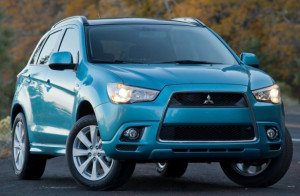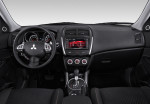Tale of Two Outliers With Outstanding MPG. The Mitsubishi AWD 30 MPG Club Members.
OK, what’s your favorite compact-vehicle flavor, crossover sport utility or four-door sedan? Mitsubishi offers both with all-wheel drive. While the EPA’s combined fuel economy estimate is 26 mpg for the Outlander Sport crossover with all-wheel drive, and 25 mpg for the Lancer SE AWC sedan, we’d like to take issue with those numbers.

We tallied a little more than 700 miles between the two vehicles, and the Outback Sport averaged 31.5 mpg while the Lancer registered 30.3 mpg. In our book, that makes them both eligible for inclusion in our Clean Fleet Report All-Wheel Drive 30 mpg Club.
There is one thing, however, that we won’t take issue with the EPA about: “Actual results (fuel economy) will vary.” Indeed, our results did vary.
Outback Sport: Great Value For The Money
Think of the Outlander Sport as an economical way to get the image of an SUV, the utility of a wagon, the all-wheel drive capability of a crossover, and the maneuverability of a small car.

As its name might suggest, the 2014 Mitsubishi Outlander Sport plays Mini Me to the “big” Mitsubishi Outlander compact sport utility, which is close in size to the Toyota RAV4. The Outlander Sport is more than a foot shorter than the Outlander in overall length and is essentially a wagon-on-stilts version of the Mitsubishi Lancer compact car.
But Mitsubishi would rather you think of it as a crossover sport utility and not a car – hence the name-association with the Outlander.
Under The Hood
Satisfied with perfectly acceptable power in low-demand driving conditions? Willing to put the gas pedal to the carpet when merging onto freeways or overtaking slower traffic? The Sport’s four-cylinder is for you.
The 2.0-liter inline four runs on regular unleaded gasoline and is rated at 148 horsepower and 145 pounds-feet of torque. While it is certainly willing, the engine’s credentials make it unreasonable to count on hefty doses of performance.
All-wheel drive models are equipped with a continuously variable transmission, a trend found on more and more vehicles. As in other applications, it offers “simulated” manual gearshifts.
Mitsubishi’s All-Wheel-Control system integrates an electronically controlled front differential. For normal driving and the best fuel economy, just leave it in 2WD. When road conditions become a little dicey, flip a rocker switch to 4WD, and the all-wheel drive mode offers improved traction in all driving conditions.
Breaking the norm for compact crossovers, there’s also a 4WD Lock mode designed for surfaces from deep snow to sand or mud. If it weren’t for the low 5.5-inch ground clearance, the 4WD setting would make the Sport a capable off roader.
Thoughtful Design, Outside And In

Model-year 2013 saw a number of exterior and interior changes to the Outlander Sport that carry over to 2014. There are a few additions for this year including a new steering wheel with audio controls and a variety of upgraded touch screens and sound systems.
As for styling, the front end’s face now has a look that resembles the Lancer Evolution performance models. A pronounced crease along the side enhances the rising window line and gives the impression the Sport is moving, even at a standstill.
The interior doesn’t offer as much visual interest, but it’s pleasing to the eyes, with switchgear that feels solid and is intuitively laid out. Fit and finish appear to be quite good and material quality is acceptable.
As a compact crossover, the Sport doesn’t squander a square inch of passenger room or cargo space. It has surprising amounts of both in a body that has presence on the road without occupying too much of it. Seating up front is comfortable, and rear passengers have a good amount of leg- and headroom and their seat backs recline, but there are no individual sliding seats. Still, the 60/40 split bench will seat two adults comfortably, and three with some liberal elbow tucking. When seatbacks are folded flat, cargo space increases from 21.7 cubic feet to 49.5.

Mitsubishi is not known for scrimping on standard features, and the entry level ES includes keyless entry, heated mirrors, tilt-and-telescoping steering wheel, height-adjustable driver seat, power locks and windows, cruise control and air conditioning. Also standard are Mitsubishi’s Fuse voice-activated interface, a four-speaker audio system with CD player, auxiliary audio input jack and USB/iPod interface.
SE models add heated front seats, automatic climate control, rain-sensing wipers and a touch-screen audio display.
Behind The Steering Wheel
On the road, our Outlander Sport SE test driver felt solid and was free of squeaks and rattles. Being based on a car, it is predictably carlike to drive. Steering is a bit inert on center, but is otherwise precise. Body lean is modest in tight turns, so the Sport can be tossed around much like a small wagon.
Ride quality is well suited for American roads, absorbing most typical road imperfections without unsettling the body. Wind noise and tire thrum are low, and, though the engine makes its presence known above 4000 rpm, it’s never irritating.
We found acceleration more than adequate in most driving conditions. However, a few times, such as merging onto freeways, we would have preferred a little more power, like maybe the 168 horsepower from the 2.4-liter four in our Lancer test driver. Then again, a larger engine would deny the Outback Sport’s inclusion in our All-Wheel Drive 30 mpg Club.
As for our 31.5 mpg, Draconian driving methods weren’t required – just common sense driving: No jack rabbit starts, an easy foot on the accelerator, lifting early when approaching stops and adhering to the 60 mph to 70 mph speed limits on freeways.
Our week with the Sport totaled 296 miles. About half were freeway miles, the balance split between city driving and two-lane highways.
Bottom Line
Mitsubishi says the Outlander Sport is the company’s top selling model, and it’s easy to see why, starting with price. The well-equipped AWD ES starts at $22,895, including destination charges. Our AWD SE was priced at $24,820 and added a Premium and Navigation package that brought the total to $28,370.
Beyond that, the Sport is easy to drive, can tote five passengers and a modest amount of cargo and, as we found, gets dang good gas mileage. Add, Mitsubishi’s 10-year/100,000-mile powertrain warranty and you have great value for the money.
Mitsubishi Lancer SE: Don’t Overlook It

A lot of folks like the confidence of an all-wheel drive setup, which offers additional traction and stability in less than ideal driving conditions. While there’s a very long list of compact crossover sport utilities to choose from, it’s slim pickings if you want a small car with AWD. The selection is even less if you want one priced under $25,000 – three to be exact: Two Subarus, the Impeza and Legacy, and Mitsubishi’s Lancer SE AWD.
A Little Long In The Tooth, But ….
Unlike competitors in the crowded compact segment, Mitsubishi’s Lancer lineup has long been in need of a major update. Still, the car’s design continues to stands apart from the crowd, beginning up front. The SE has a toned-down Lancer trademark contentious shark-like grille, pointed headlamps and sculpted hood. The stance is low and lean, and in profile offers a well-proportioned appearance. The backside is tidy with a small spoiler that adds a sporty touch.

Inside is where the Lancer lets you know that 2008 was the last time it was an all-new car. Reflective of that time, hard plastic and low-grade-looking materials dominate the cabin. That said, for 2014 Mitsubishi upgraded the seating fabric in the Lancer, and the SE receives a backup camera, a new touchscreen audio display and an upgraded audio system that includes HD radio and SiriusXM satellite radio.
The dash has a clean, uncluttered design with a hooded instrument cluster featuring white on black gauges. Controls lay easily to hand and large climate control knobs have a quality feel.
Passengers will find more than adequate leg- and headroom in both the front and rear seats. On a seven-hour round trip we found the front bucket seats to be firm and supportive with the bonus of heated bottoms and seat backs. The steering wheel tilts but doesn’t telescope, which could be a deal breaker for those over six feet.
Trunk space is on the small side at 12.3 cubic feet and, if you opt for the Rockford-Fosgate audio system, the trunk-mounted subwoofer cuts it to 11.8 cubic feet. However, 60/40 split folding rear seats offer more generous space.
On The Road
With nearly a half a liter more displacement than the Outlander Sport’s engine, the Lancer SE’s 2.4-liter four-cylinder produces 168 horsepower and 167 pound-feet of torque. It delivers brisk takeoffs, is peppy, cruises without strain at 70 mph and becomes vocal only at higher rpm.
We were impressed with the continuously variable transmission (CVT), the only transmission offered. Unlike others of its type, engine rpm never raced ahead of vehicle speed, and it acted like, well, a standard automatic.

Power steering is hydraulic rather than the electric system on the Sport. It is quick and accurate, and sends enough feedback through the wheel to keep the driver connected to the road. The SE employs the same All Wheel Control system as the Outlander Sport. Cornering grip is noticeably increased when flipping the switch to all-wheel drive, making the Lancer SE fun to throw around corners.
Ride and handling are a well-balanced combination for a compact size car. The all-independent suspension is quite good at compensating for road irregularities and only major potholes can shake its composure.
A weekend visit with our oldest son accounted for 312 freeway miles of our total 441 miles during our week with the Lancer. The balance was divided between in town and two-lane country roads. Again, sensible driving netted really good fuel economy – 30.3 mpg.
Bottom Line
Priced starting at $21,490, the Lancer SE AWD doesn’t offer the latest in tech, safety and comfort features, but it does come with a credible list of standard features like heated outside mirrors and front seats. Also included are keyless entry, power windows and locks as well as cruise control and steering wheel controls for audio and Bluetooth connectivity.

Available are a navigation system and Mitsubishi’s Fuse infotainment system. Fuse is an easy-to-use touchscreen-based software that features voice command in addition to knobs and buttons that functions very well.
Sporty design, sharp handling, bountiful cabin space and a comprehensive warranty overshadow an outdated interior. If you want the security that all-wheel drive offers, the Lancer SE AWC is a sensible alternative for those who don’t want what everyone else is driving.
Photos by the manufacturer
Posted April 30, 2014
Other related stories you might enjoy:
Comparison Road Test: 2014 Prius vs. Plug-in Prius
Top 2014 AWD & 4WD SUVs/Crossovers with the best MPG
Road Test: 2014 Subaru Forester

0 thoughts on “Comparison Road Test: 2014 Mitsubishi AWD Choice: Compact Crossover or Compact Sedan”